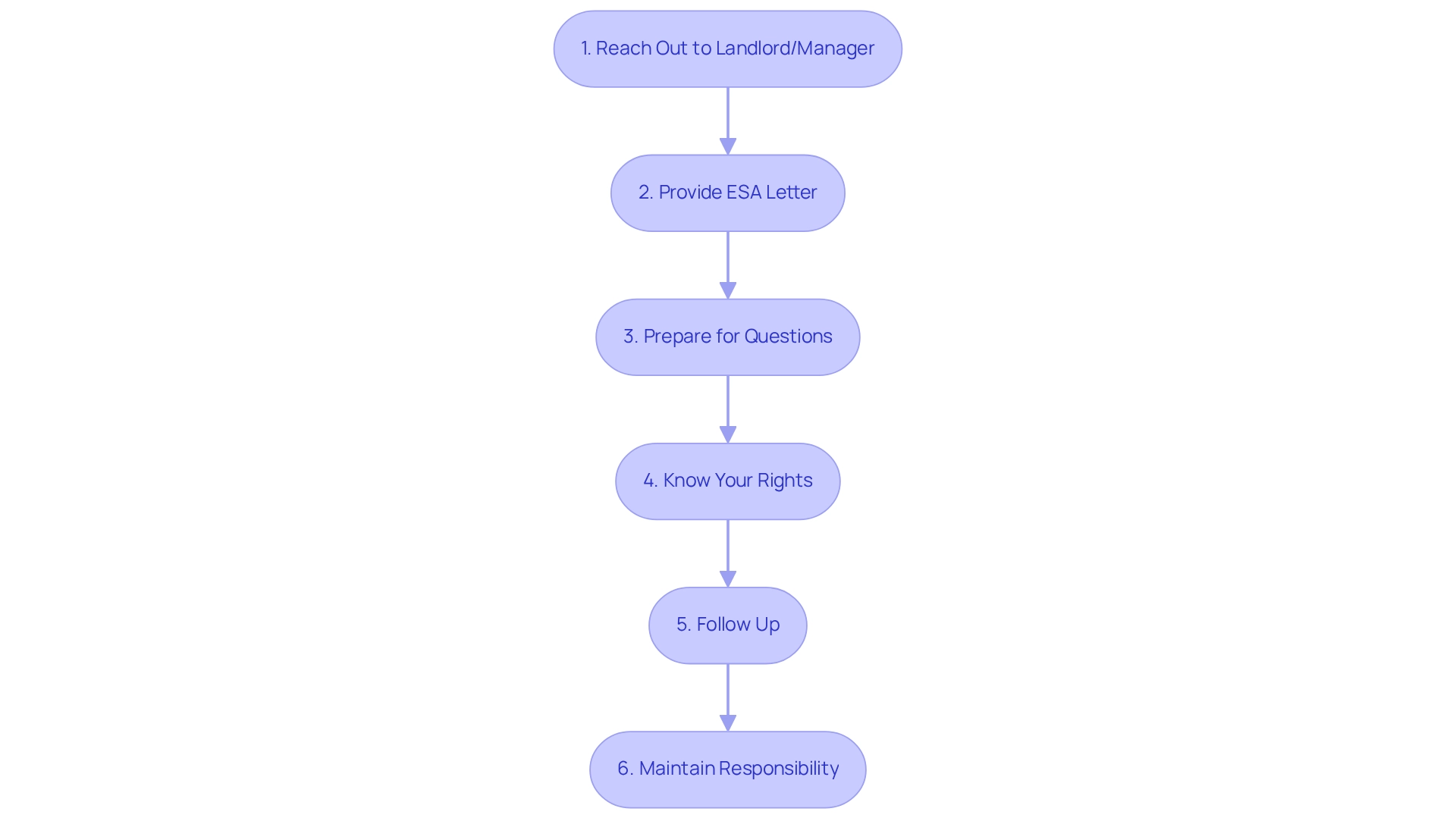

How to Register Cat as Emotional Support Animal: A Step-by-Step Guide
by Lena Park
Last updated: June 26, 2025
Verified and Approved by:
Angela Morris,
MSW, LCSW
Fact Checked

Overview
Registering a cat as an emotional support animal (ESA) can be a vital step for individuals navigating the complexities of mental health challenges. It begins with a heartfelt consultation with a licensed mental health professional, who can assess your psychological needs and provide you with a formal ESA letter. This process not only ensures that your cat’s behavior is suitable but also involves gathering necessary documentation and understanding your legal rights regarding housing accommodations. These steps are crucial, as they support the profound emotional benefits that ESAs can offer to their owners.
Many individuals face emotional struggles that can feel overwhelming at times. The companionship of an ESA can bring comfort and relief, helping to ease feelings of anxiety and loneliness. By obtaining an ESA letter, you open the door to a supportive relationship with your cat, one that nurtures your emotional well-being.
It’s important to remember that you are not alone in this journey. The process may seem daunting, but with the right guidance and support, you can secure the emotional connection that an ESA provides. Reflect on your own experiences—how might a furry companion help you feel more at ease?
As you move forward, know that there are compassionate resources available to assist you. The love and support of an emotional support animal can be a transformative experience, offering not just companionship, but a pathway to healing and hope.
Introduction
Navigating the process of registering a cat as an emotional support animal can feel overwhelming, yet it offers the promise of greatly enhancing one’s emotional well-being. Many individuals face the silent battle of anxiety, depression, or PTSD, and as awareness around mental health grows, the vital role of emotional support animals is increasingly acknowledged. These companions provide comfort and solace during challenging times.
This article aims to guide you through the essential steps for:
- Determining eligibility
- Gathering the necessary documentation
- Effectively presenting an ESA letter to housing providers
By understanding your rights and responsibilities, you can access the support you deserve. With compassionate guidance, you can embark on a meaningful journey toward emotional healing alongside your feline friend.
Assess Your Eligibility for an Emotional Support Cat
To determine your eligibility for registering your cat as an assistance animal, please consider the following steps:
- Consult a Licensed Health Specialist: It’s essential to arrange a meeting with a therapist, psychologist, or psychiatrist who can assess your psychological health needs. Be open about your emotional challenges and how a cat could provide comfort and support. Research shows that individuals who seek ESA letters often experience significant improvements in their well-being, including reduced feelings of loneliness and enhanced coping skills. For students, this support can lead to improved psychological well-being, potentially decreasing dropout rates and enhancing academic performance.
- Discuss Your Requirements: During your consultation, clearly articulate why you believe a therapy cat would positively impact your psychological health. Conditions such as anxiety, depression, or PTSD are often mentioned. Mental health professionals stress the importance of this dialogue, as it helps them understand your unique circumstances and the potential role of your cat in your emotional support.
- Acquire a Diagnosis: If the mental health expert determines that you have a qualifying condition, they will provide a diagnosis that supports your need for an ESA. Current statistics indicate that about 70% of individuals seeking ESAs qualify based on their psychological health conditions, reinforcing the validity of this support system. It’s important to familiarize yourself with the legal requirements for registering your cat as an emotional support animal, as these can differ by state. Generally, you will need a letter from your mental health provider confirming your need for an ESA. This documentation is vital for accessing housing and travel accommodations under laws such as the Fair Housing Act and the Air Carrier Access Act. Understanding the differences between ESAs and Service Animals is crucial, as ESAs do not have the same access rights but still provide significant psychological support.
- Assess Your Cat’s Behavior: Ensure your cat is well-mannered and can offer the comfort you seek. While there are no specific training requirements for ESAs, a calm and friendly demeanor is beneficial. Cats, along with dogs and small mammals, are among the most common companion animals, highlighting their ability to provide solace to individuals with diagnosed psychological or mental disorders. According to regulations for assistance animals, the creature’s ability to offer reassurance is essential for fulfilling its purpose.

Gather Required Documentation for Registration
To effectively gather the necessary documentation for registering your cat as an emotional support animal, it’s important to approach this process with care and understanding. Here are some steps to guide you:
- Obtain an ESA Letter: Begin by securing a formal letter from your licensed health professional. This letter should include your name, the date of issuance, a statement confirming your diagnosis and the necessity of an ESA for your treatment, and the psychological health professional’s contact details and license number. It’s crucial that the letter is printed on official letterhead to ensure its validity.
- Check Local Regulations: Take the time to investigate any specific requirements or additional documentation mandated by your state or locality. The rules concerning assistance animals can differ greatly, and being knowledgeable about these can alleviate some stress.
- Prepare Additional Documentation: While not always mandatory, having supplementary documents, such as your pet’s vaccination records or a detailed pet profile, can be beneficial, especially when interacting with landlords or airlines. If you plan to travel with Air Canada, remember to complete the U.S. DOT form and notify the Medical Assistance Desk at least 48 hours before your flight. A letter from your mental health professional is also recommended to ensure a smooth check-in experience.
- Understand Air Canada’s Policies: It’s important to be aware that Air Canada no longer recognizes comfort animals; however, psychiatric service dogs can travel with the proper documentation. Familiarize yourself with their pet carrier size requirements and any applicable pet fees, which can vary based on flight type. Additionally, please note that snub-nosed breeds may face limitations when traveling.
- Keep Copies: Always make several copies of your ESA letter and any other relevant documentation. This practice ensures that you have immediate access to these important documents whenever necessary.
With a valid ESA letter, individuals can avoid paying pet deposits and fees in housing situations, which is essential for understanding how to register your cat as an emotional support animal. Research has shown that therapy animals significantly improve social interactions and general well-being, underscoring the importance of appropriate documentation in obtaining these benefits. As highlighted by HABRI, “Pets provide psychological comfort and a sense of purpose and connection,” further emphasizing the assistance that ESAs offer. Moreover, with over 50,000 patients served, Wellness Wag offers flexible payment plans starting as low as $32.25, making their services accessible to those in need.
Present Your ESA Letter to Housing Providers
Navigating the process of presenting your ESA letter to housing providers can feel overwhelming, but with the right approach, you can make it a smoother experience. Here are some supportive steps to guide you:
-
First, reach out to your landlord or property manager. Initiate a conversation to inform them of your need for a companion cat. It’s important to document this interaction in writing, as it helps maintain a record of your communication.
-
Next, provide your ESA letter. Include a copy with your correspondence, ensuring that the letter is comprehensive and contains all the necessary details outlined previously. This will help clarify your situation.
-
Be prepared for questions. Your landlord may have inquiries about your ESA, so anticipate these discussions. Reflect on your own experiences and be ready to articulate the mental health benefits your cat brings to your life.
-
It’s essential to know your rights. Familiarize yourself with the Fair Housing Act, which protects tenants with assistance animals. Understanding your rights empowers you to advocate for your needs effectively. While service dog owners enjoy full public access rights under the Americans with Disabilities Act (ADA), those seeking to register their cat as an emotional support animal also have protections, especially in housing contexts. ESA owners are entitled to reasonable accommodations, even in places where pets are usually not allowed. Sadly, many tenants face housing discrimination related to their ESAs, often unaware of their rights. In fact, a significant percentage of ESA owners report challenges when seeking housing accommodations.
-
If you don’t receive a response in a reasonable timeframe, it’s important to follow up. Reach out to your landlord to confirm receipt of your request and to inquire about their decision.
-
Additionally, remember that you are responsible for cleaning up after your ESA and maintaining your rental property properly (Pettable Academy). By being informed and proactive, you can navigate these challenges more effectively. Successful communication with housing providers often hinges on clarity and preparedness, ensuring that your needs are understood and respected. You might even consider referencing case studies or examples of successful communication with housing providers to reinforce the effectiveness of these steps.
As you embark on this journey, remember that you are not alone. There is support available, and with each step, you are advocating for your well-being.

Conclusion
Registering a cat as an emotional support animal can feel like a daunting journey, yet it holds the promise of significantly enhancing emotional well-being for those grappling with mental health challenges. It all begins with assessing eligibility—this crucial step involves consulting a licensed mental health professional who can provide a diagnosis and an ESA letter. This letter is not just a formality; it legitimizes the need for an emotional support cat, ensuring access to essential housing and travel accommodations.
The next vital step is gathering the required documentation. This includes:
- Securing a formal ESA letter
- Understanding local regulations
- Preparing any supplementary documents that might be beneficial
Keeping copies of these documents close at hand ensures readiness when engaging with landlords or airlines, which can lead to smoother interactions and help reduce potential obstacles.
Finally, presenting the ESA letter effectively to housing providers is essential for securing the rights and accommodations that emotional support animal owners deserve. A solid understanding of the Fair Housing Act, along with preparation for discussions with landlords, can empower individuals to advocate for their needs confidently. By following these steps—assessing eligibility, gathering documentation, and communicating effectively—individuals can navigate the process with assurance, ensuring that their emotional support cat can provide the comfort and companionship vital for a healthier, happier life.
Frequently Asked Questions
What is the first step to determine eligibility for registering my cat as an assistance animal?
The first step is to consult a licensed health specialist, such as a therapist, psychologist, or psychiatrist, who can assess your psychological health needs and discuss how a cat could provide comfort and support.
Why is it important to discuss my requirements with a mental health professional?
Discussing your requirements helps the mental health professional understand your unique circumstances and the potential positive impact a therapy cat could have on your psychological health, particularly if you experience conditions like anxiety, depression, or PTSD.
What happens after consulting with a mental health expert?
If the mental health expert determines that you have a qualifying condition, they will provide a diagnosis that supports your need for an emotional support animal (ESA). You will also need a letter from your mental health provider confirming this need for registration purposes.
What percentage of individuals seeking ESAs typically qualify based on psychological health conditions?
Approximately 70% of individuals seeking ESAs qualify based on their psychological health conditions.
What documentation is necessary for registering a cat as an ESA?
You will need a letter from your mental health provider confirming your need for an ESA. This documentation is essential for accessing housing and travel accommodations under laws such as the Fair Housing Act and the Air Carrier Access Act.
How do emotional support animals (ESAs) differ from service animals?
ESAs do not have the same access rights as service animals but still provide significant psychological support.
What should I assess about my cat before registering it as an ESA?
You should assess your cat’s behavior to ensure it is well-mannered and can offer the comfort you seek. A calm and friendly demeanor is beneficial, even though there are no specific training requirements for ESAs.
What types of animals are commonly recognized as emotional support animals?
Cats, along with dogs and small mammals, are among the most common companion animals recognized as emotional support animals.
Certify Your Emotional Support Animal Today

Why You Can Rely on Us?
At Wellness Wag, we believe your pet deserves care rooted in both science and compassion. Each article is carefully researched, written in clear language for pet owners, and then reviewed by qualified professionals to ensure the information is evidence-based, current, and practical for real-life care. Our goal is to help you feel confident in making informed decisions about your pet’s health and well-being.
Reviewed by
Angela Morris, MSW, LCSW
Angela is a licensed clinical social worker with 20 years of experience in patient advocacy and community mental health. She has assisted numerous clients with ESA evaluations and brings a deep understanding of disability accommodations, ensuring that all information is accurate, supportive, and practical.

Written by :
Lena Park
Last Updated :
June 26, 2025












